
It’s 2am on a hot and humid Sunday morning. The house just fell silent less than an hour ago. Until then, the downstairs of this grand old Victorian had seen a steady parade of skaters coming to and fro, and of projects being attended to that have to be held to their various deadlines. But now, all is quiet. The skaters have either turned in for the night, or bailed for an impromptu midnight session somewhere. And just under my ass, in the basement of this stately old house with cathedral ceilings and heavy, aged oak sliding doors sits a 600-ton skateboard press, quietly crushing the next batch of blanks that will be Fickle Skateboards’ next round of prototype decks.
If you read Kilwag’s series in Concrete Wave Mag, then you’ll certainly know that most skateboard companies… maybe “virtually all skateboard companies” would be far more accurate… all follow the same modus operandi. Some dude wants to start a business. An art direction is laid down, a few neato gimmicks are thought up, and some sort of skateboard superstar team is employed and/or exploited to endorse it. Then, somebody calls up some anonymous woodshop somewhere, and orders a bunch of product. That’s right kids: 99.999% of all skateboard “companies” don’t actually make a damned thing. Instead, the tedious task of actually making the product is usually outsourced to some little Chinese dude on the other side of the pond that has probably, most likely, never skated a day in his entire life. And that’s just the way it goes. That’s why most of us in the know, in the industry, call these businesses “skateboard peddlers” or “skateboard marketers”, not what the average kid on the street usually refers to as a “skateboard company”.
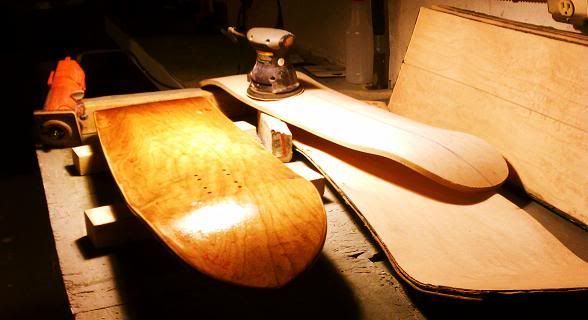
"Handmade by skaters, for skaters". A great ideal that, unfortunately, is rarely realized anymore. But, here? It's just the way it is. Photography by Aaron Ross.
Fickle actually started out in the very same manner. Call woodshop, send graphics, get the boards in, and turn ‘em around for some fast cash. But only a year into the process, the same wrench in the cogs that derails so many other small start-up “skateboard companies” began to muck up Fickle’s plans as well. Skateboard woodshops, after all, do have a nasty tendency of being a little bit hard to work with, and a whole lot of shady and unreliable. Fickle’s woodshop was no different. The first time that I met Lew Ross, the guy behind Fickle, he told me that something like 30% of his boards would arrive, up to par. Which meant that an astounding 70% of his decks would show up in a subpar state. Colors being not what they had specified. Cracks and putty marks in the wood. Gaping glue lines. Holes drilled everywhere but where they should’ve been. Knots and fissures in the face plys. Lews theory was that, even though he was one of the bigger-volume customers for this woodshop… he was still getting what were essentially “seconds” (rejects), yet still being charged for prime grade wood. Somehow, somewhere, there just had to be a better way.
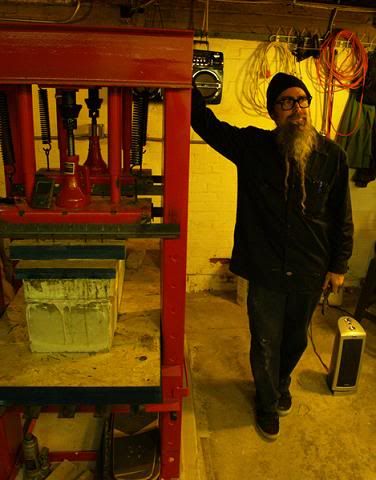
Lew Ross, and the prototype press. Photography by Aaron Ross.
“New board brands, take note: There is no incentive for wood factories, no matter how cool they may seem on the phone, to tell you the truth about what kind of wood you'll get, or when you'll get it...”
- Lew Ross
When Lew and I first met, Lew was at the very beginning of the process of grappling with what to do next. The woodshop wasn’t cooperating, that was for damned sure. But what’s the alternative? Move to another less-than-upright woodshop, and blindly hope and pray beyond hope and prayer for the best? Or take matters into your own hands, and have a go at pressing your own boards, in your own presses? Clearly, the latter would pose a very clear and present risk: Setting up a fully functioning woodshop is in no way, shape, or form, “easy”. On the other hand: It’s definitely not impossible. Lots of guys- from Paul Schmitt, all the way to Danny Creadon- have done it, and done it successfully. And in Danny’s case, done it on a small (read: affordable) enough scale to make it a practical proposition for most ambitious skaters. “Ambitious” being the key word here. If Lew was gonna go with the woodshop, he was gonna have to go all the way, and make it work out come hell or high holy water. Because once he started down that road, there’d just be no going back. The financial commitment alone could sink a guy real quick. Never mind the time and struggle that such an experiment would surely require.
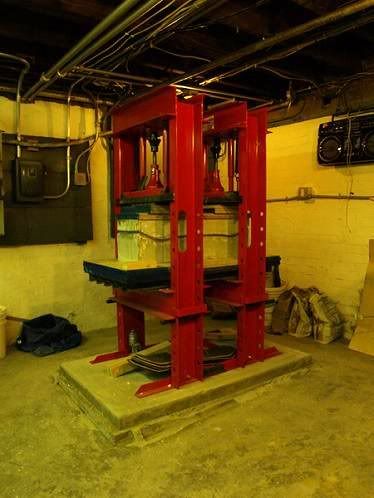
The press. There's now another half-dozen of these in the permanent woodshop, cranking out 50 decks a day. Aaron Ross photography.
Add to that, that Lew’s not an engineer in any way, shape, or form (he’s actually an ordained minister in the Christian church), and you can see right away that this could be a journey fraught with all sorts of risks and uncertainties. Thankfully for skateboarding, we’ve been blessed with a certain amount of ancestral knowledge from highly articulate and enlightened sources. One of those being Mr. Craig R. Stecyk the 3rd. His mantra- that “an unsure thing beats a sure thing every time”- certainly held true thirty years ago when he first said it. And thankfully for the rest of us, it still holds true today. If order comes from chaos, then chaos must be a pretty damn good place to start. The basement of Lew’s house was pretty damned chaotic, so it was decreed that this is where the prototype woodshop would be constructed. Aged wiring was ripped out and replaced with industrial-grade stock. Piles of random stuff were cleared aside for a climate-controlled wood storage room. Stone walls were cleaned and painted over with two-part epoxy for a silkscreening shop… because if you’re gonna go legit, you might as well go all the way, right? Various glues were assessed and compared. And finally, the first pallets of skateboard-grade maple veneer arrived, partitioned, and stored away to acclimate to the ambient environment.
Lew might not have known what the hell he was doing. But he sure as heck wasn’t screwing around, either.
“Things that are healthy, grow…”
-Lew Ross’ guiding principle of business
While the wood sat and did its acclimating bit, another parallel project unfolded. Just five miles away from where my ass sits, is the Fickle Conceptual Corporate Headquarters. Located in Over-The-Rhine in Cincinnati’s old industrial district, the Fickle HQ is where the “training facility” and future production center are located. It’s an old, concrete-block warehouse with leaky walls, old wooden rafters, and ample sky lighting… but it’s got charm, it’s got history, and it’s gigantic, so it works uniquely well for the purpose. And the mini-ramp that’s on-site is an absolute dream to skate. About 3’ 9”’ tall, and 21’ wide with 7.5’ transitions, and a spine that leads out to what will soon be the street area. It’s actually a salvaged vert ramp that was built to survive an Armageddon, and it is solid as a rock. I died a little bit skating it yesterday, and my knees are quietly revolting… but it was well worth the toil and the toll. There just aren’t many mini-ramps anywhere that can stand this strong, and skate this smoothly. You can trust me on this, because we all know that I’ve spent a lifetime looking for one.
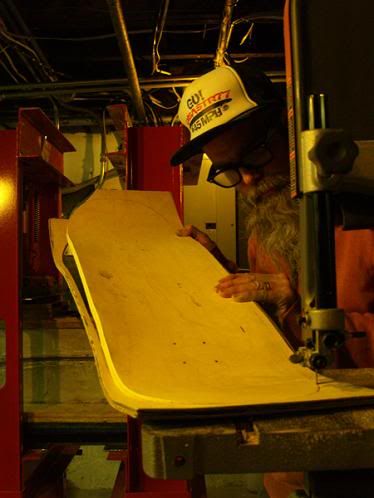
Lew, getting his hands dirty in the shaping room. Aaron Ross photography.
Back in the basement a few hours later, I watched Lew load up another board into the press. It’s really quite an experience, seeing a skateboard being born. Lew only uses about 500 gallons of glue on each deck, because profits aren’t really a priority… but dammit, building a tank-proof skateboard sure is. Then, he slides it into his custom-crafted concrete molds, and sets the cranks of his press into motion. He wrestles with the cranks for a half-hour or so, all that excess glue spurts out all over the place, and then the battle’s over. Twelve hours or so later… Lew loves long press times almost as much as he loves slathering glue everywhere… the blank emerges, and is again left to acclimate and cure for several days before it’s sent to the band saw and the laminate trimmers. Every single deck is cut, shaped, drilled, and finished by skaters that know what they’re doing, and that make every single thing as if they were gonna ride it themselves.
This is in no way a mass-production sort of deal. Rather, it’s an evolving process of carefully crafting singular pieces of art for an excessively demanding demographic. A good example of an “excessively demanding demographic” would be the Fickle team. Which is populated by local rippers like Weston Vickers, Ben Osborne, Native Nik, Aaron Ross (Lew’s son), and Lew Himself. Guys that you haven’t heard of (yet)… but wait a minute, because you just did. The biggest trademark of Team Fickle is that they’re genuinely nice guys… that much is apparent, right from the first meeting… that make a habit of slaying whatever gnarly-ass terrain gets in their way. Bigger is always better, and these kids don’t play around.
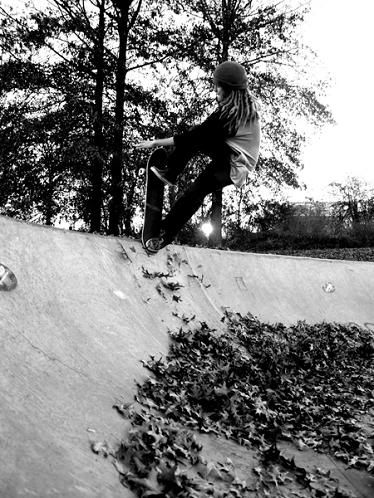
Weston Vickers, blunt fakie at Dry Ridge, Kentucky. Aaron Ross photogaphy.
“Initiative” is a great concept that just isn’t embraced enough these days. Most skaters act like primadonna little bitches that seem to expect every great thing in life to be hand-delivered to them on a silver platter. Well, skateboarding just doesn’t work like that, kiddies. What we have here is a paradigm shift of the highest order, and everything else just looks a little bit lazy and stale in comparison. The trick to getting it done, and done right, is getting your hands dirty and not accepting your own self-imposed limitations. If Lew and Crew have shown us anything at all, it’s that everything you want and need are right there in front of you, plump and ripe for the picking. All you’ve gotta do is stand up, stand tall, and go after it. The trick to getting on the winning program is as easy and simple as investing, and believing, in yourself.
